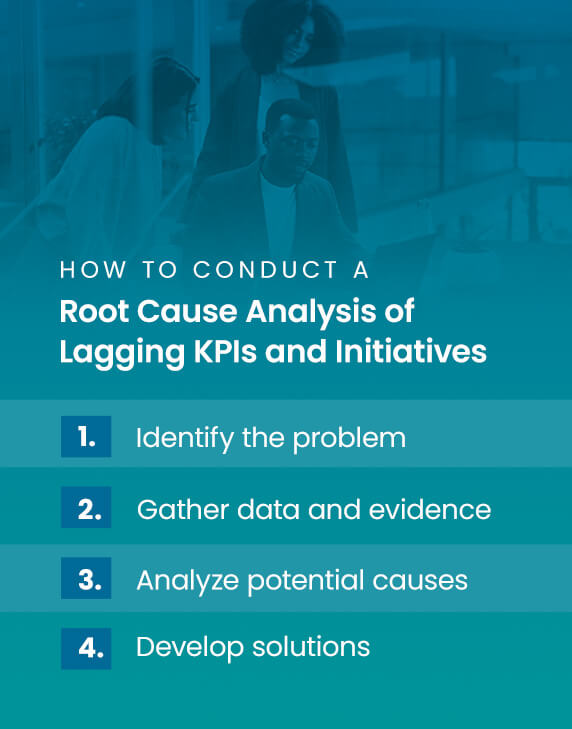When your company’s strategy software lights up with an alert, it can be worrying. This is especially true if you aren’t sure what the alert means or if you have no clue how to address the underlying issue. It may be tempting to simply avoid the alert altogether, but doing so allows the problem to persist, which can result in harm to your company and its long-term strategic efforts. Resolving the issue, however, is not always simple or easy. Luckily, the alert gives you a more specific sense of what’s wrong so you can take the necessary action quickly.
That’s where this guide comes in. We will show you how to interpret your strategy software’s alerts and implement corrective actions. If the alert is handled correctly, you can help get your company back on track and avoid long-term harm. We’ll even go over tools and methodologies that can assist with diagnosis and strategic execution going forward.
In This Article
- Strategy Alerts and How They Work
- How to Respond to Strategy Alerts
- The Strategy Review Meeting Process
- How to Conduct a Root Cause Analysis of Lagging KPIs and Initiatives
- How to Act on KPI Data Software Insights
- How to Fix Off-Track Initiatives
Strategy Alerts and How They Work
Strategy alerts are a core part of strategy execution tools. They warn you of potential issues affecting your company’s ability to reach its goals. These alerts are typically triggered when something your company is tracking — key performance indicators (KPIs), initiative rollouts, goals and more — goes off track, falls outside an accepted range or fails to reach a certain threshold within a specified time frame. The alert itself, which typically manifests as a red status pop-up, will tell you more about why it has been triggered.
These alert notifications can also be tailored so that only certain users receive them. For instance, if a new company initiative is not hitting the desired KPIs, the chief strategy officer (CSO) needs to know as soon as possible so they can alter the company’s approach. Most team members don’t need to know, however. Their role is not to make high-level decisions about company strategy, so there’s no need to give them something else to worry about when they have no power to fix or control it.
Alert notifications may appear across different interconnected platforms if your company relies on multiple pieces of strategic software. For example, your KPI monitoring software may send you an alert that your company failed to reach its revenue growth goals for the quarter. You are likely to receive a similar alert from your enterprise strategy execution platform if you use one.

Regardless of where the alert comes from, it should be dealt with quickly. Failing to do so may exacerbate the problem and prevent your company from adjusting course. Responding quickly, however, can lead to enormous dividends. It can save floundering product launches, reenergize company morale and open up new opportunities for growth. Strategy alerts facilitate all of these benefits, but only if your company acts on them.
How to Respond to Strategy Alerts
Responding to strategy alerts can be challenging. The complexity of managing corporate strategy, company budget and all the other factors that lead to strategy alerts can make it hard to diagnose the root cause and take corrective action.
You can alleviate some of that complexity by taking several steps at the outset. These steps are designed to help you assess and categorize the alert so your company can respond to it more effectively:
1. Assess the Severity of the Alert
Some strategy alerts are more pressing than others. Before panicking or taking corrective action, it’s important to read the alert carefully and assess the severity of the problem it is identifying. If the alert has come up before, the problem may have relapsed or grown worse since the previous alert. If the alert is new, however, you may have more room to consider the issue and adapt to it more slowly.
2. Gather Relevant Data and Insights
This data can clarify the severity of the problem and how urgently a strategic response is needed. It will also inform the response, especially if your strategy execution tools provide KPI data analysis. Applications with data analytics capabilities leverage advanced software, machine learning and all the information your applications collect to generate data-driven insights for users. These insights can help you identify statistical patterns and potential avenues for improvement.
3. Prioritize Alerts Based on Importance and Urgency
Sometimes, multiple strategy alerts will be triggered at once. This can be very distressing, but it’s important to breathe and gather information before acting. The alerts may be minor or completely unrelated. Whatever the case, you should assess each alert carefully to determine which ones warrant an immediate response and which ones can be dealt with more slowly. Then, you can respond to them in order of importance and urgency.
4. Communicate With Team Members
Other stakeholders should be included throughout the response process. They can provide unique insights into the problem and assist with brainstorming potential solutions. Many companies choose to do both in the form of strategy review meetings, where decision-makers can come together to discuss alerts and how to resolve them.
Strategic alerts take many forms and will require many different solutions as a result. That said, these general steps will help you and your company begin to address the issue you’re facing effectively. From there, you can work together to bring the errant KPIs or missed targets back on track.
The Strategy Review Meeting Process
One of the most effective ways to address an alert is to hold a strategy review meeting with relevant decision-makers. These meetings can take many forms and should be tailored to meet the needs and preferences of your group. Generally speaking, however, the goal should be to inform everyone of the alert and discuss what the company’s response should be.
This goal can be achieved by sticking to the following strategy review meeting process:
- Review current KPIs and initiatives: Effective strategy meetings start by providing everyone involved with context. Begin by discussing the status of your company’s selected KPIs to get a sense of its position. You can use statistics, graphs and other data to get everyone up to speed quickly. The performance of ongoing initiatives should also be included in this discussion. A deep understanding of these topics and your company’s overall health will facilitate the next steps in the meeting process.
- Discuss strategy alerts and their implications: Once a context has been established, you can turn the discussion toward the strategy alert. People will likely have questions and concerns, so be prepared to address them calmly using the information you’ve acquired since the alert was received. Discussion can then move to the implications of the alerts, such as what caused it and how it should be responded to. At this stage, the floor should be open to everyone so that ideas and critiques flow freely from one person to the next.
- Set action items and accountability assignments: Before the meeting ends, you and the other decision-makers should set action items that need to be accomplished in response to the alert. It should also be clear who is responsible for each action item on the list. The items may vary in scale, so entire departments may need to act to take care of certain items on the list, while others can be achieved by just a single person.
In order to get the most out of these strategy review meetings, you should adhere to the following practices:
- Set clear objectives at the outset: Doing so keeps the meeting focused and productive. It also allows you to assess the effectiveness of the meeting upon completion. If all or most objectives were achieved, then it was a successful meeting.
- Always encourage open dialogue: The best way to generate new ideas and improve existing ones is to allow everyone to speak their minds. During the meeting, everyone should be encouraged to share their opinions and notes openly, regardless of status. This will lead to more productive dialogue and better solutions.
- Be open to new possibilities: Resolving strategic issues often requires unconventional thinking, especially if your company is battling a recurring problem. Conventional wisdom has its place as well, but don’t let a reliance on convention stop the consideration of new ideas. The market is always changing, after all. Sometimes, you may have to change with it.
How to Conduct a Root Cause Analysis of Lagging KPIs and Initiatives

While the strategy review meeting may assist with narrowing down the cause of the strategy alert, more digging may be required. That’s where a root cause analysis for KPIs, initiatives and other alert triggers comes in. This process is designed to help you investigate lagging KPIs and the like so that you can develop a firm grasp of what is causing them in the first place.
Here are the steps of an effective root cause analysis:
- Identify the problem: This step is relatively simple. The strategy alert itself will inform you of the problem, whether it’s an off-track initiative or a quarterly goal that was not reached. To really understand that problem, however, you have to dig deeper.
- Gather data and evidence: Once the problem has a name, you can focus on its symptoms. These will vary based on the problem, but they will always manifest tangibly in the form of data points and deadlines, as these are what the strategy execution tools track. Collecting these data points will enhance your ability to identify the cause of the alert and provide evidence of that cause to other decision-makers.
- Analyze potential causes: The data points you collect may point to a range of potential causes, so it’s important to weigh all the available explanations. Attempting to redress a potential cause that isn’t actually the reason for the alert can lead to wasted time and resources. That’s why it’s important to gather as much evidence as possible before acting. This includes talking with stakeholders relevant to each potential cause. They may be able to provide insight that the data alone cannot, which can narrow down your list of causes.
- Develop solutions: Once you have narrowed down the potential causes as much as possible, it is time to start crafting solutions. This process may take more time, but caution and precision are needed here. You and your team may also need to develop multiple solutions if it is still unclear what is causing the strategy alert. Having multiple corrective strategies in your back pocket also gives your team more agility and avenues for redressing the issue. If one doesn’t work, you can simply eliminate that line of attack and try another.
You can also employ a range of methodologies to assist a root cause analysis. Two of the most common and effective are the Five Whys and the fishbone diagram.
The Five Whys is a methodology designed to get to the root of a problem by asking a series of questions — the titular Five Whys. In this methodology, your job is to adopt the mindset of a curious child. You don’t literally have to ask why five times, but you do need to keep asking until you reach the initial cause of the problem. This process helps you dig deeper into the problem and treat the cause rather than the symptoms.
The fishbone diagram is a bit more complex. This methodology encourages your team to brainstorm potential causes for the problem your company is facing. These causes, such as staffing, workplace processes or resource management, form the ribs of the fish. Those causes are then given their own causes in the form of lines extending from the ribs. Resource management, for instance, might have a line labeled “poorly integrated software.” Appropriate solutions can then be implemented.
How to Act on KPI Data Software Insights
Strategy alerts can provoke a whole host of responses, especially when KPIs are involved. Your instinct may be to radically change course or eliminate perceived excesses in response to the stress. Acting on KPI data software insights should not be governed by instinct, however. All strategic solutions should be carefully considered and based on tangible and measurable evidence. In this way, your KPIs are both the problem and the solution. By tracking their data across time, you give yourself the tools you need to assess the problem and find a way to fix it.

Making KPI data-driven decisions is only the start. The solutions also need to align with your company’s strategic goals. If a given approach is too costly or would compromise a corporate expansion into a new sector, it may not be worth it. The value of the KPI must be weighed against long-term considerations like these. This is why acting on software insight requires careful consideration, collaboration and flexible thinking before corrective action.
How to Fix Off-Track Initiatives
Fixing off-track initiatives is a bit different, as initiatives are directly connected to customers and employees. Numbers are easy to play with, but the things the numbers describe aren’t always as flexible, especially when there’s a human element involved. There will likely be a lot of trial and error involved when trying to help a wayward initiative reach its goals.
Luckily, there are many tools for fixing off-track initiatives. KPI monitoring software is one, but performance management and plan management software can provide a more hands-on approach. These tools can help you reassess initiative goals and timelines. They also assist with initiative planning and execution by allowing you to set and manage goals and tasks at every scale of the process. These features can help you narrow down exactly where things went wrong, which makes fixing off-track initiatives much easier.
Reach Your Full Potential With AchieveIt

Resolving strategy reports is made easy with AchieveIt’s Integrated Plan Management platform. Our software supports plan creation, progress management, plan management and performance assessment, all in one place. You can use these features to manage initiatives and set and track goals at scale. This turns increased KPIs from a dream to an actionable process. It makes fixing off-track initiatives not just possible but practical.
To learn more about AchieveIt, request a demo today or give us a call at 844-431-7165.



